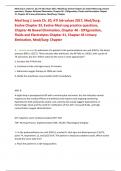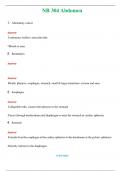Med Surg 1 Lewis Ch. 20, ATI lab values 2017, Med/Surg: Evolve Chapter 33, Evolve Med surg practice
questions, Chapter 46 Bowel Elimination, Chapter 40 - OXYgenation, Fluids and Electrolytes Chapter
41, Chapter 45 Urinary Elmination, Med/Surg: Chapter
Med Surg 1 Lewis Ch. 20, ATI lab values 2017, Med/Surg:
Evolve Chapter 33, Evolve Med surg practice questions,
Chapter 46 Bowel Elimination, Chapter 40 - OXYgenation,
Fluids and Electrolytes Chapter 41, Chapter 45 Urinary
Elmination, Med/Surg: Chapter
1. - correct answer On admission of a patient to the postanesthesia care unit (PACU), the blood
pressure (BP) is 122/72. Thirty minutes after admission, the BP falls to 114/62, with a pulse of
74 and warm, dry skin. Which action by the nurse is most appropriate?
a. Increase the IV fluid rate.
b. Continue to take vital signs every 15 minutes.
c. Administer oxygen therapy at 100% per mask.
d. Notify the anesthesia care provider (ACP) immediately.
ANS: B
A slight drop in postoperative BP with a normal pulse and warm, dry skin indicates normal
response to the residual effects of anesthesia and requires only ongoing monitoring.
Hypotension with tachycardia and/or cool, clammy skin would suggest hypovolemic or
hemorrhagic shock and the need for notification of the ACP, increased fluids, and high-
concentration oxygen administration.
DIF: Cognitive Level: Analyze (analysis) REF: 356
TOP: Nursing Process: Implementation MSC: NCLEX: Physiological Integrity
2. In the postanesthesia care unit (PACU), a patient's vital signs are blood pressure 116/72,
pulse 74, respirations 12, and SpO2 91%. The patient is sleepy but awakens easily. Which action
should the nurse take first?
a. Place the patient in a side-lying position.
,Med Surg 1 Lewis Ch. 20, ATI lab values 2017, Med/Surg: Evolve Chapter 33, Evolve Med surg practice
questions, Chapter 46 Bowel Elimination, Chapter 40 - OXYgenation, Fluids and Electrolytes Chapter
41, Chapter 45 Urinary Elmination, Med/Surg: Chapter
b. Encourage the patient to take deep breaths.
c. Prepare to transfer the patient to a clinical unit.
d. Increase the rate of the postoperative IV fluids.
ANS: B
The patient's borderline SpO2 and sleepiness indicate hypoventilation. The nurse should
stimulate the patient and remind the patient to take deep breaths. Placing the patient in a
lateral position is needed when the patient first arrives in the PACU and is unconscious. The
stable blood pressure and pulse indicate that no changes in fluid intake are required. The
patient is not fully awake and has a low SpO2, indicating that transfer from the PACU to a
clinical unit is n
- correct answer
Sodium - correct answer 136-145 mEq/L
Potassium - correct answer 3.5-5.0 mEq/L
Total Calcium - correct answer 9-10.5 mg/dL
Magnesium - correct answer 1.3.-2.1 mg/dL
Phosphorus - correct answer 3.0-4.5 mg/dL
BUN - correct answer 10-20 mg/dL
Serum Creatinine for male - correct answer 0.6-1.2mg/dL
Serum creatinine for female - correct answer 0.5-1.1mg/dL
Glucose - correct answer 70-105 mg/dL
HgA1c - correct answer <6.5%
WBC - correct answer 5,000-10,000
RBC for males - correct answer 4.7-6.1 million
RBC for females - correct answer 4.2-5.4 million
Hemoglobin for males - correct answer 14-18g/100mL for male
Hemoglobin for females - correct answer 12-16g/100mL
,Med Surg 1 Lewis Ch. 20, ATI lab values 2017, Med/Surg: Evolve Chapter 33, Evolve Med surg practice
questions, Chapter 46 Bowel Elimination, Chapter 40 - OXYgenation, Fluids and Electrolytes Chapter
41, Chapter 45 Urinary Elmination, Med/Surg: Chapter
Platelet - correct answer 150,000-400,000
Hematocrit for male - correct answer 42-52%
Hematocrit for female - correct answer 37-47%
pH - correct answer 7.35-7.45
pCO2 - correct answer 35-45 mm Hg
pO2 - correct answer 80-100 mm Hg
HCO3 - correct answer 21-26 mmole/L
Normal PT - correct answer 11-12.5 sec
Normal INR - correct answer 0.7-1.8
Therapeutic INR (when receiving Coumadin) - correct answer 2-3
Normal aPTT - correct answer 30 to 40 sec
Therapeutic PT - correct answer 1.5-2 times normal (11-12.5)
Therapeutic aPTT - correct answer 1.5-2 times normal (30-40 sec)
Chloride - correct answer 98 to 106 mEq/L
Erythrocyte sedimentation rate (ESR) - correct answer Less than 20 mm/hr
Total serum cholesterol - correct answer Desirable less than 200 mg/dL (risk for cardiac or
stroke event with levels greater than 150 mg/dL)
LDL (low-density lipids) - correct answer Desirable less than 130 mg/dL
HDL (high-density lipids) - correct answer Males: >45 mg/dL
Females: >55 mg/dL
Triglycerides - correct answer Desirable less than 150 mg/dL; males 40-160 mg/dL; females 35-
135 mg/dL
Albumin - correct answer 3.5-5 g/dL
Ammonia - correct answer 15 to 45 mcg/dL
Total bilirubin - correct answer 0.1 to 1.0 mg/dL
Total protein - correct answer 6 to 8 g/dL
Urine specific gravity - correct answer 1.005 to 1.030
, Med Surg 1 Lewis Ch. 20, ATI lab values 2017, Med/Surg: Evolve Chapter 33, Evolve Med surg practice
questions, Chapter 46 Bowel Elimination, Chapter 40 - OXYgenation, Fluids and Electrolytes Chapter
41, Chapter 45 Urinary Elmination, Med/Surg: Chapter
Urine protein - correct answer 0-8 mg/dL
Urine glucose - correct answer Less than 0.5 g/day
Urine ketones - correct answer None (negative)
Urine pH - correct answer 4.6-8
Creatinine clearance test - correct answer Males: 90-139 mL/min
Females: 80-125 mL/min
Digoxin therapeutic range - correct answer 0.8 to 2.0 ng/mL
Lithium therapeutic range - correct answer 0.4 to 1.4 mEq/L
Phenobarbital therapeutic range - correct answer 10 to 40 mcg/mL
Dilantin therapeutic range - correct answer 10 to 20 mcg/dL
A male patient who has coronary artery disease (CAD) has serum lipid values of low-density
lipoprotein (LDL) cholesterol of 98 mg/dL and high-density lipoprotein (HDL) cholesterol of 47
mg/dL. What should the nurse include in patient teaching? - correct answer The lipid levels are
normal.
*rationale*
For men, the recommended *LDL is less than 100 mg/dL*
and the recommended level for *HDL is
greater than 40mg/dL*
His normal lipid levels should be included in the patient teaching and encourage him to
continue taking care of himself. Assessing his need for teaching related to diet should also be
done.
A 74-yr-old man with a history of prostate cancer and hypertension is admitted to the
emergency department with substernal chest pain. Which action will the nurse complete
before administering sublingual nitroglycerin? - correct answer Obtain a 12-lead
electrocardiogram (ECG).





